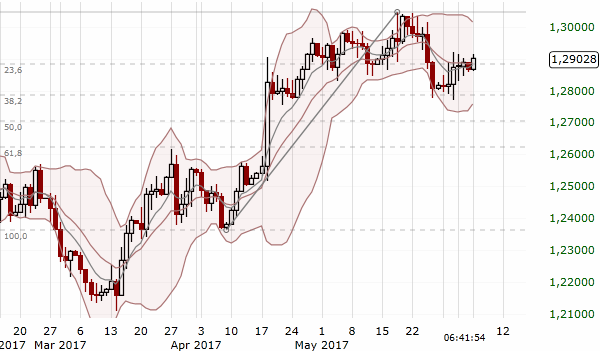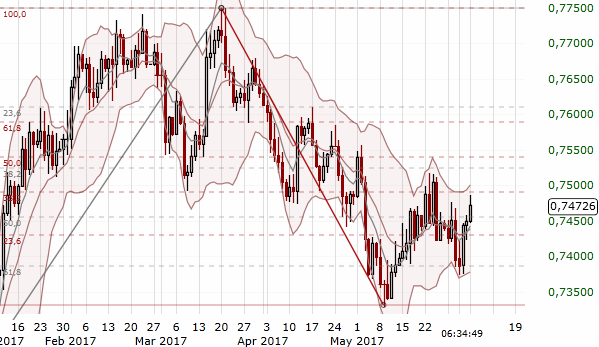EUR/USD jumped after U.S. jobs report, now eyes on ECB
Macroeconomic overview: U.S. job growth slowed in May and employment gains in the prior two months were not as strong as previously reported, suggesting the labor market was losing momentum despite the unemployment rate falling to a 16-year low of 4.3%.
Nonfarm payrolls increased 138k last month as the manufacturing, government and retail sectors lost jobs. The economy created 66k fewer jobs than previously reported in March and April.
Details of the employment report were weak. Though the unemployment rate fell one-tenth of a percentage point to its lowest level since May 2001, that was because 429k people dropped out of the labor force.
Average hourly earnings rose 0.2% in May after a similar gain in April, leaving the year-on-year increase in wages at 2.5%.
In our opinion last month's job gains could still be sufficient for the Federal Reserve to raise interest rates at its June 13-14 policy meeting.
The modest payrolls gain could temper expectations of a sharp acceleration in economic growth in the second quarter after gross domestic product increased at a tepid 1.2% annualized rate at the start of the year. While consumer spending picked up in April, a second report on Friday showed the trade deficit widening 5.2% to USD 47.6 billion. The Atlanta Fed is forecasting GDP increasing at a 3.4% pace in the second quarter.
There was some good news in the employment report. A broad measure of unemployment, which includes people who want to work but have given up searching and those working part-time because they cannot find full-time employment, fell two-tenths of a percentage point to 8.4%, the lowest since November 2007. As a result, the spread between the jobless rate and this broad unemployment gauge, considered a better measure of labor market slack, was the smallest since early 2008.
The dollar edged up on Monday, but remained not far from the seven-month low it plumbed against a currency basket after disappointing U.S. employment data prompted investors to pare back expectations of U.S. Federal Reserve rate hikes. While market participants still expect the U.S. central bank to raise interest rates this month, many expect a more dovish course for the second half of this year.
The most important event this week will be the ECB decision on Monday. We expect some important changes to ECB communication at the nearest meeting. Ongoing strength in surveys and, to a somewhat lesser extent, hard data will likely convince the Governing Council to turn less cautious and formally upgrade its growth outlook for the Eurozone. This is likely to be done by acknowledging that growth risks have shifted from the downside to broadly balanced. The ECB has already set the stage for such a move, flagging over the last two-to-three months a progressive reduction of downside risks. The intention is to make any rhetoric shift as gradual as possible in order to reduce the probability of an unwarranted tightening of financial conditions.
Technical analysis:
The EUR/USD broke above May 23 high on Friday after lower-than-expected U.S. non-farm payroll data. Although the pair is still above positively aligned short-term moving averages, we think that a corrective move is likely in the coming days. We think that the EUR/USD will fall if ECB disappoints markets with less hawkish statement on Thursday. 
Short-term signal: We expect that the volatility will be higher in the coming days. In our opinion a stronger fall in the EUR/USD is likely if the ECB is less hawkish than expected. We will be hunting for lower levels to get long in line with our long-term bullish outlook.
Long-term outlook: Bullish
GBP/USD recoveries after poll shows conservative leading by 11 points
Macroeconomic overview: British services PMI fell to a three-month low of 53.8 from 55.8 the month before, at the low end of market expectations.
The British economy looks as if it has recovered some of its momentum after slowing in the first three months of 2017, when the cost of the pound's fall after last year's Brexit vote caught up with consumers. But PMI data increased the risks that quarterly growth in the overall economy might not hit its forecast of 0.5%. In the first quarter, growth slowed to just 0.2%.
Optimism about the year ahead is running below the long-run average, weighed down principally by concerns over Brexit, political uncertainty and weaker spending by households.
The services PMI does not cover retailers, who suffered their worst quarter since 2010 in the first three months of the year, and appear to have struggled again last month after a brief respite in April. The CBI's monthly retail sales balance slid back to +2 in May from +38 in April, a four-month low.
Saturday's attack - the third in England in three months - saw sterling slip from to 1.2851 at the start of Asian trading. But the GBP turned positive against the dollar on Monday after a poll showed British Prime Minister Theresa May's Conservative Party leading by 11 points over the opposition party ahead of a national election this week. May's lead slipped from a lead of 12 percentage points in a previous ICM/Guardian poll published a week ago, but the Conservatives' lead as measured by ICM is wider than in several opinion polls conducted by other firms.
Technical analysis: The pair is fluctuating near 23.6% fibo of April-May rally. The nearest resistance level is May 31 high at 1.2921.Technical analysis provides no clear buy/sell signal for the GBP/USD. The market will be focused on two events this week - general election and ECB meeting on Thursday. 
Short-term signal: Stay short for 1.2680
Long-term outlook: Flat
AUD/USD went up after Australian inventories data
Macroeconomic overview: Australian second-quarter GDP data will be release on June 7. Some investors had feared Australian economy may actually have gone backwards in the first quarter following disappointing readings on retail sales and home building. The risk of an outright contraction did look to have diminished slightly on Monday as data showed inventories held by firms jumped a surprisingly large 1.2% in the quarter. That alone should add around 0.4 percentage points to GDP growth. Our economists estimate that Australian economy grew by 0.2% in the first quarter.
Government figures out on Monday showed wages and salaries paid by businesses across the country bounced just 0.3% in the first quarter, after a 0.5% drop the previous quarter.
Wage growth for the year to March was only 0.9%, well below consumer price inflation of 2.1%. Spare capacity in the labour market is expected to continue to weigh on wage growth over the next year. This in turn, is likely to have implications for consumption growth given the high levels of household debt and expected moderation in house price growth.
The danger is all the greater as household debt is at all-time highs and red-hot housing markets in Sydney and Melbourne are vulnerable to a major correction. The heat in housing has made the Reserve Bank of Australia reluctant to cut interest rates further, even as consumers struggle. The central bank holds its June policy meeting on Tuesday and is considered certain to keep rates at 1.5%, where they have been stuck since May last year.
Technical analysis: The AUD/USD broke above 23.6% fibo of April-May fall and the nearest resistance level is 38.2% fibo at 0.7491, just below the psychological barrier of 0.7500. A break above 7-day exponential moving average is another bullish signal for the coming days. 
Short-term signal: We have placed a bid at 0.7430.
Long-term outlook: Bullish
TRADING STRATEGIES SUMMARY:
FOREX - MAJOR PAIRS: 
Source: GrowthAces.com - your daily forex trading strategies newsletter
